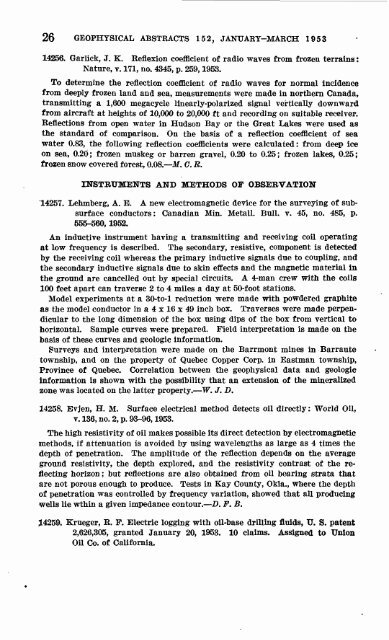Geophysical Abstracts 152 January-March 1953
Geophysical Abstracts 152 January-March 1953
Geophysical Abstracts 152 January-March 1953
You also want an ePaper? Increase the reach of your titles
YUMPU automatically turns print PDFs into web optimized ePapers that Google loves.
26 GEOPHYSICAL ABSTRACTS <strong>152</strong>, JANUARY-MARCH <strong>1953</strong><br />
14256. Garlick, J. K. Reflexion coefficient of radio waves from frozen terrains:<br />
Nature, v. 171, no. 4345, p. 259,<strong>1953</strong>.<br />
To determine the reflection coefficient of radio waves for normal incidence<br />
from deeply frozen land and sea, measurements were made in northern Canada,<br />
transmitting a 1,600 megacycle linearly-polarized signal vertically downward<br />
from aircraft at heights of 10,000 to 20,000 ft and recording on suitable receiver.<br />
Reflections from open water in Hudson Bay or the Great Lakes were used as<br />
the standard of comparison. On the basis of a reflection coefficient of sea<br />
water 0.83, the following reflection coefficients were calculated: from deep ice<br />
on sea, 0.20; frozen muskeg or barren gravel, 0.20 to 0.25; frozen lakes, 0.25;<br />
frozen snow covered forest, 0.08. M. C. R.<br />
INSTRUMENTS AND METHODS OF OBSERVATION<br />
T.4257. Lehmberg, A. E. A new electromagnetic device for the surveying of sub<br />
surface conductors: Canadian Min. Metall. Bull. v. 45, no. 485, p.<br />
555-560,1952.<br />
An inductive instrument having a transmitting and receiving coil operating<br />
at low frequency is described. The secondary, resistive, component is detected<br />
by the receiving coil whereas the primary inductive signals due to coupling, and<br />
the secondary inductive signals due to skin effects and the magnetic material in<br />
the ground are cancelled out by special circuits. A 4-man crew with the coils<br />
100 feet apart can traverse 2 to 4 miles a day at 50-foot stations.<br />
Model experiments at a 30-to-l reduction were made with powdered graphite<br />
as the model conductor in a 4 x 16 x 49 inch box. Traverses were made perpen<br />
dicular to the long dimension of the box using dips of the box from vertical to<br />
horizontal. Sample curves were prepared. Field interpretation is made on the<br />
basis of these curves and geologic information.<br />
Surveys and interpretation were made on the Barrmont mines in Barraute<br />
township, and on the property of Quebec Copper Corp. in Eastman township,<br />
Province of Quebec. Correlation between the geophysical data and geologic<br />
information is shown with the possibility that an extension of the mineralized<br />
zone was located on the latter property. W. J. D.<br />
14258. Evjen, H. M. Surface electrical method detects oil directly: World Oil,<br />
v. 136, no. 2, p. 93-96,<strong>1953</strong>.<br />
The high resistivity of oil makes possible its direct detection by electromagnetic<br />
methods, if attenuation is avoided by using wavelengths as large as 4 times the<br />
depth of penetration. The amplitude of the reflection depends on the average<br />
ground resistivity, the depth explored, and the resistivity contrast of the re<br />
flecting horizon; but reflections are also obtained from oil bearing strata that<br />
are not porous enough to produce. Tests in Kay County, Okla., where the depth<br />
of penetration was controlled by frequency variation, showed that all producing<br />
wells lie wthin a given impedance contour. D. F. B.<br />
14259. Krueger, R. F. Electric logging with oil-base drilling fluids, U. S. patent<br />
2,626,305, granted <strong>January</strong> 20, <strong>1953</strong>. 10 claims. Assigned to Union<br />
Oil Co. of California.

















